He Korowai Oranga: Strategy, Rationale, and Initiatives Analysis
VerifiedAdded on 2023/06/03
|12
|2773
|294
Report
AI Summary
This report provides an analysis of the He Korowai Oranga health strategy, also known as the Maori health strategy of New Zealand, which serves as an overarching framework guiding the government and health sector to achieve optimal health outcomes for the Maori community. The strategy emphasizes holistic models and well-being, supporting the health of Whanau, Hapu, and Iwi, and aims to improve health and wellbeing, reduce respiratory illness in infants, improve employment, reduce inequity, and foster community development. The analysis covers the strategy's aims, including providing a platform for better health and well-being, addressing health issues such as lack of access to patient-centric care and resources, and initiatives like improving housing and increasing employment and education. The report concludes that the He Korowai Oranga strategy is crucial for achieving good health and wellbeing for the Maori community by removing barriers and encouraging community participation.
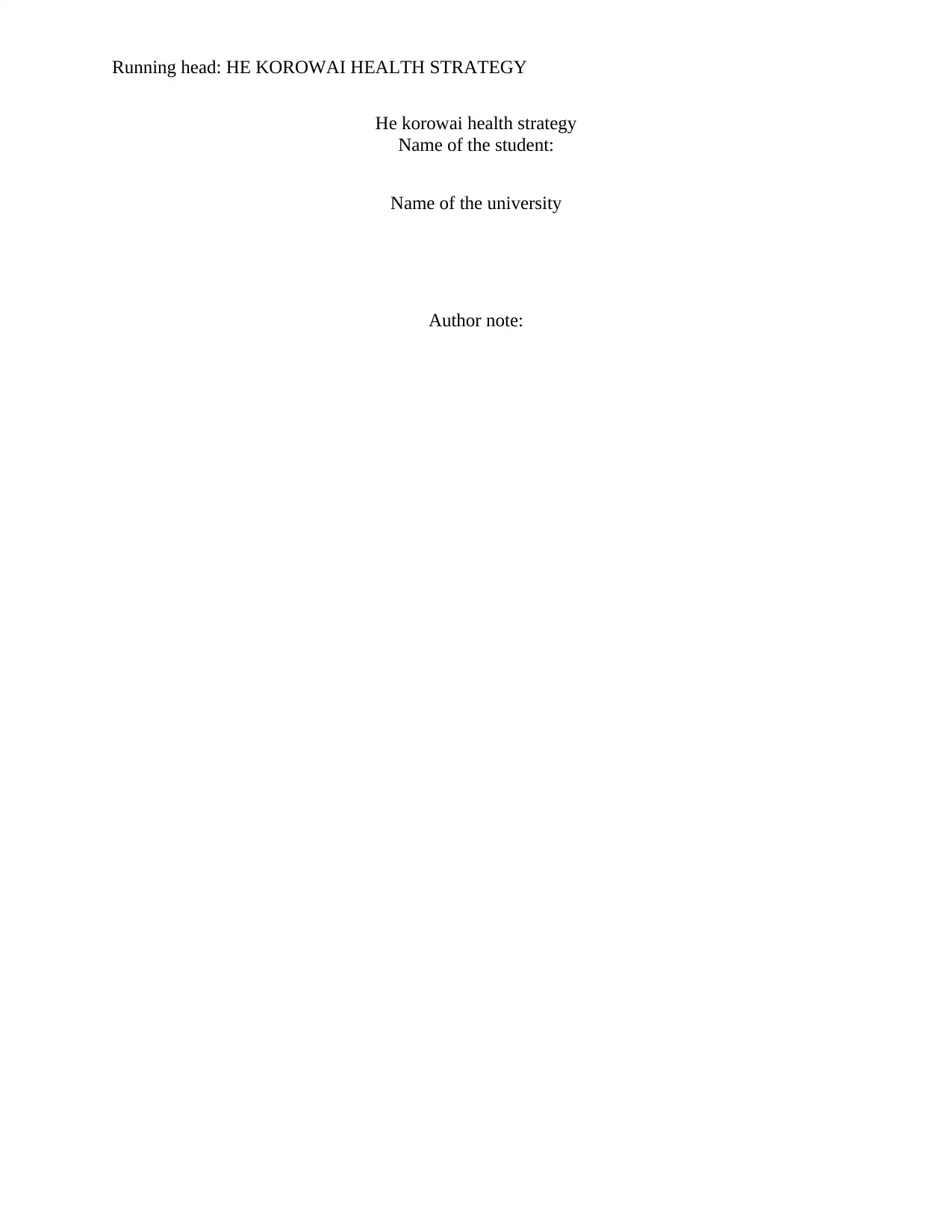
Running head: HE KOROWAI HEALTH STRATEGY
He korowai health strategy
Name of the student:
Name of the university
Author note:
He korowai health strategy
Name of the student:
Name of the university
Author note:
Paraphrase This Document
Need a fresh take? Get an instant paraphrase of this document with our AI Paraphraser
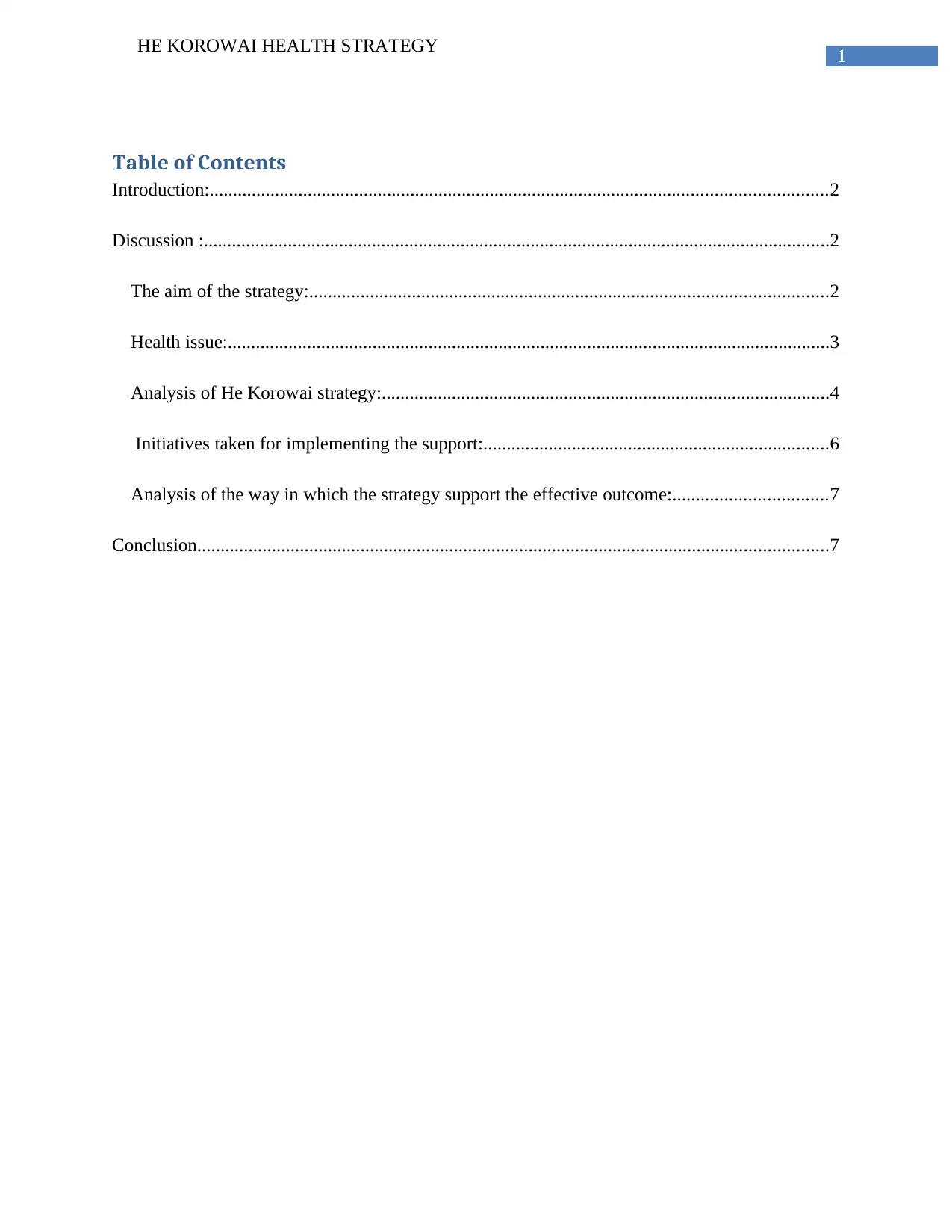
1
HE KOROWAI HEALTH STRATEGY
Table of Contents
Introduction:....................................................................................................................................2
Discussion :......................................................................................................................................2
The aim of the strategy:...............................................................................................................2
Health issue:.................................................................................................................................3
Analysis of He Korowai strategy:................................................................................................4
Initiatives taken for implementing the support:..........................................................................6
Analysis of the way in which the strategy support the effective outcome:.................................7
Conclusion.......................................................................................................................................7
HE KOROWAI HEALTH STRATEGY
Table of Contents
Introduction:....................................................................................................................................2
Discussion :......................................................................................................................................2
The aim of the strategy:...............................................................................................................2
Health issue:.................................................................................................................................3
Analysis of He Korowai strategy:................................................................................................4
Initiatives taken for implementing the support:..........................................................................6
Analysis of the way in which the strategy support the effective outcome:.................................7
Conclusion.......................................................................................................................................7
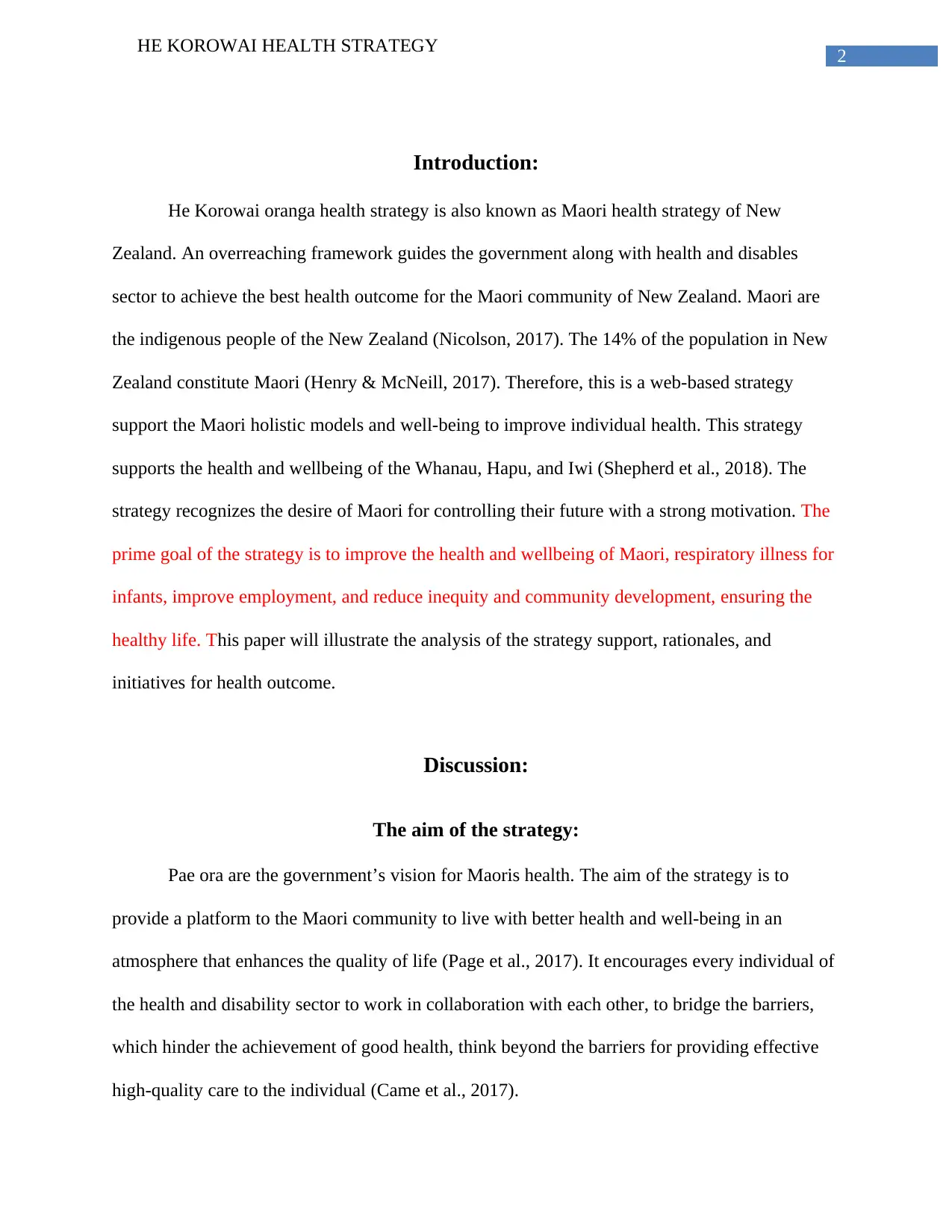
2
HE KOROWAI HEALTH STRATEGY
Introduction:
He Korowai oranga health strategy is also known as Maori health strategy of New
Zealand. An overreaching framework guides the government along with health and disables
sector to achieve the best health outcome for the Maori community of New Zealand. Maori are
the indigenous people of the New Zealand (Nicolson, 2017). The 14% of the population in New
Zealand constitute Maori (Henry & McNeill, 2017). Therefore, this is a web-based strategy
support the Maori holistic models and well-being to improve individual health. This strategy
supports the health and wellbeing of the Whanau, Hapu, and Iwi (Shepherd et al., 2018). The
strategy recognizes the desire of Maori for controlling their future with a strong motivation. The
prime goal of the strategy is to improve the health and wellbeing of Maori, respiratory illness for
infants, improve employment, and reduce inequity and community development, ensuring the
healthy life. This paper will illustrate the analysis of the strategy support, rationales, and
initiatives for health outcome.
Discussion:
The aim of the strategy:
Pae ora are the government’s vision for Maoris health. The aim of the strategy is to
provide a platform to the Maori community to live with better health and well-being in an
atmosphere that enhances the quality of life (Page et al., 2017). It encourages every individual of
the health and disability sector to work in collaboration with each other, to bridge the barriers,
which hinder the achievement of good health, think beyond the barriers for providing effective
high-quality care to the individual (Came et al., 2017).
HE KOROWAI HEALTH STRATEGY
Introduction:
He Korowai oranga health strategy is also known as Maori health strategy of New
Zealand. An overreaching framework guides the government along with health and disables
sector to achieve the best health outcome for the Maori community of New Zealand. Maori are
the indigenous people of the New Zealand (Nicolson, 2017). The 14% of the population in New
Zealand constitute Maori (Henry & McNeill, 2017). Therefore, this is a web-based strategy
support the Maori holistic models and well-being to improve individual health. This strategy
supports the health and wellbeing of the Whanau, Hapu, and Iwi (Shepherd et al., 2018). The
strategy recognizes the desire of Maori for controlling their future with a strong motivation. The
prime goal of the strategy is to improve the health and wellbeing of Maori, respiratory illness for
infants, improve employment, and reduce inequity and community development, ensuring the
healthy life. This paper will illustrate the analysis of the strategy support, rationales, and
initiatives for health outcome.
Discussion:
The aim of the strategy:
Pae ora are the government’s vision for Maoris health. The aim of the strategy is to
provide a platform to the Maori community to live with better health and well-being in an
atmosphere that enhances the quality of life (Page et al., 2017). It encourages every individual of
the health and disability sector to work in collaboration with each other, to bridge the barriers,
which hinder the achievement of good health, think beyond the barriers for providing effective
high-quality care to the individual (Came et al., 2017).
⊘ This is a preview!⊘
Do you want full access?
Subscribe today to unlock all pages.

Trusted by 1+ million students worldwide
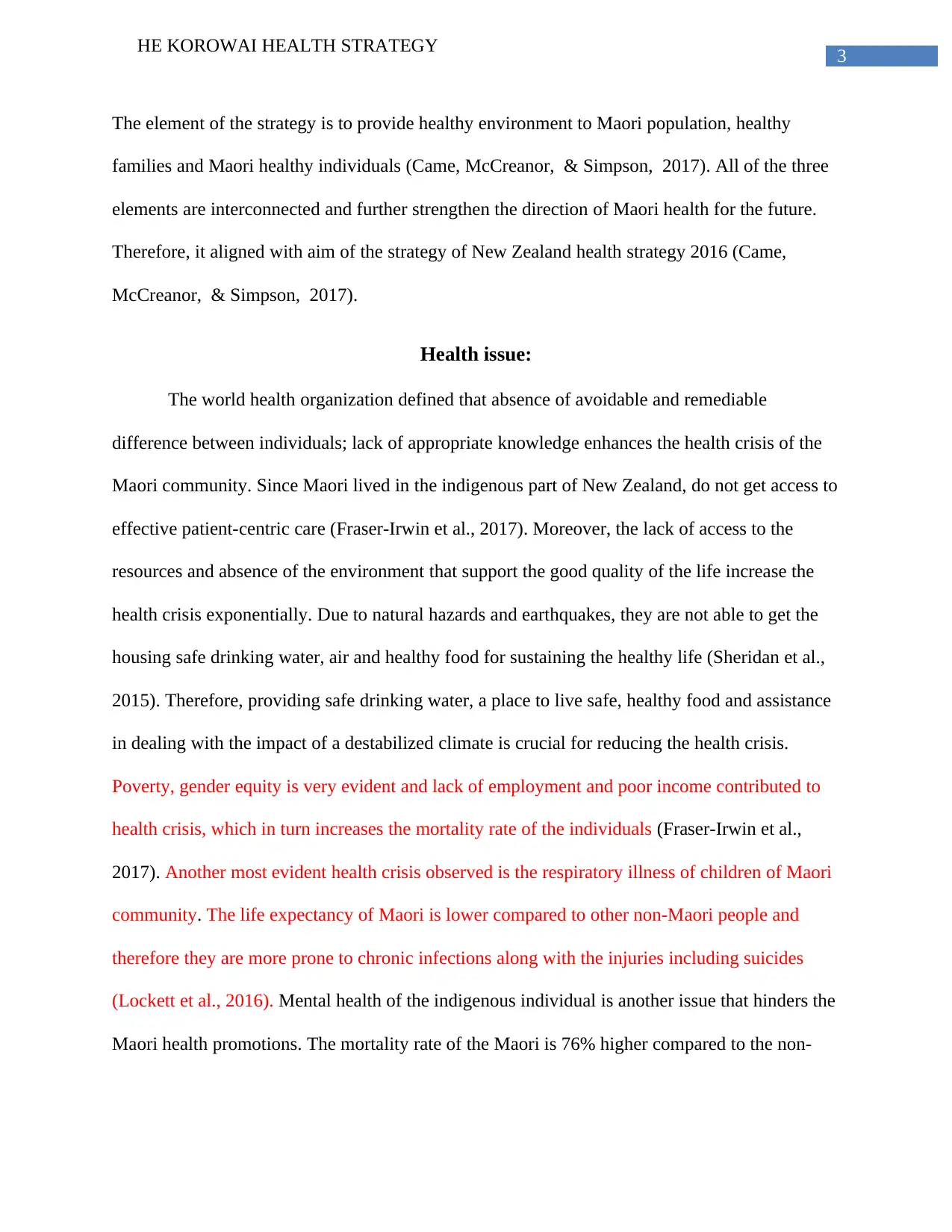
3
HE KOROWAI HEALTH STRATEGY
The element of the strategy is to provide healthy environment to Maori population, healthy
families and Maori healthy individuals (Came, McCreanor, & Simpson, 2017). All of the three
elements are interconnected and further strengthen the direction of Maori health for the future.
Therefore, it aligned with aim of the strategy of New Zealand health strategy 2016 (Came,
McCreanor, & Simpson, 2017).
Health issue:
The world health organization defined that absence of avoidable and remediable
difference between individuals; lack of appropriate knowledge enhances the health crisis of the
Maori community. Since Maori lived in the indigenous part of New Zealand, do not get access to
effective patient-centric care (Fraser-Irwin et al., 2017). Moreover, the lack of access to the
resources and absence of the environment that support the good quality of the life increase the
health crisis exponentially. Due to natural hazards and earthquakes, they are not able to get the
housing safe drinking water, air and healthy food for sustaining the healthy life (Sheridan et al.,
2015). Therefore, providing safe drinking water, a place to live safe, healthy food and assistance
in dealing with the impact of a destabilized climate is crucial for reducing the health crisis.
Poverty, gender equity is very evident and lack of employment and poor income contributed to
health crisis, which in turn increases the mortality rate of the individuals (Fraser-Irwin et al.,
2017). Another most evident health crisis observed is the respiratory illness of children of Maori
community. The life expectancy of Maori is lower compared to other non-Maori people and
therefore they are more prone to chronic infections along with the injuries including suicides
(Lockett et al., 2016). Mental health of the indigenous individual is another issue that hinders the
Maori health promotions. The mortality rate of the Maori is 76% higher compared to the non-
HE KOROWAI HEALTH STRATEGY
The element of the strategy is to provide healthy environment to Maori population, healthy
families and Maori healthy individuals (Came, McCreanor, & Simpson, 2017). All of the three
elements are interconnected and further strengthen the direction of Maori health for the future.
Therefore, it aligned with aim of the strategy of New Zealand health strategy 2016 (Came,
McCreanor, & Simpson, 2017).
Health issue:
The world health organization defined that absence of avoidable and remediable
difference between individuals; lack of appropriate knowledge enhances the health crisis of the
Maori community. Since Maori lived in the indigenous part of New Zealand, do not get access to
effective patient-centric care (Fraser-Irwin et al., 2017). Moreover, the lack of access to the
resources and absence of the environment that support the good quality of the life increase the
health crisis exponentially. Due to natural hazards and earthquakes, they are not able to get the
housing safe drinking water, air and healthy food for sustaining the healthy life (Sheridan et al.,
2015). Therefore, providing safe drinking water, a place to live safe, healthy food and assistance
in dealing with the impact of a destabilized climate is crucial for reducing the health crisis.
Poverty, gender equity is very evident and lack of employment and poor income contributed to
health crisis, which in turn increases the mortality rate of the individuals (Fraser-Irwin et al.,
2017). Another most evident health crisis observed is the respiratory illness of children of Maori
community. The life expectancy of Maori is lower compared to other non-Maori people and
therefore they are more prone to chronic infections along with the injuries including suicides
(Lockett et al., 2016). Mental health of the indigenous individual is another issue that hinders the
Maori health promotions. The mortality rate of the Maori is 76% higher compared to the non-
Paraphrase This Document
Need a fresh take? Get an instant paraphrase of this document with our AI Paraphraser
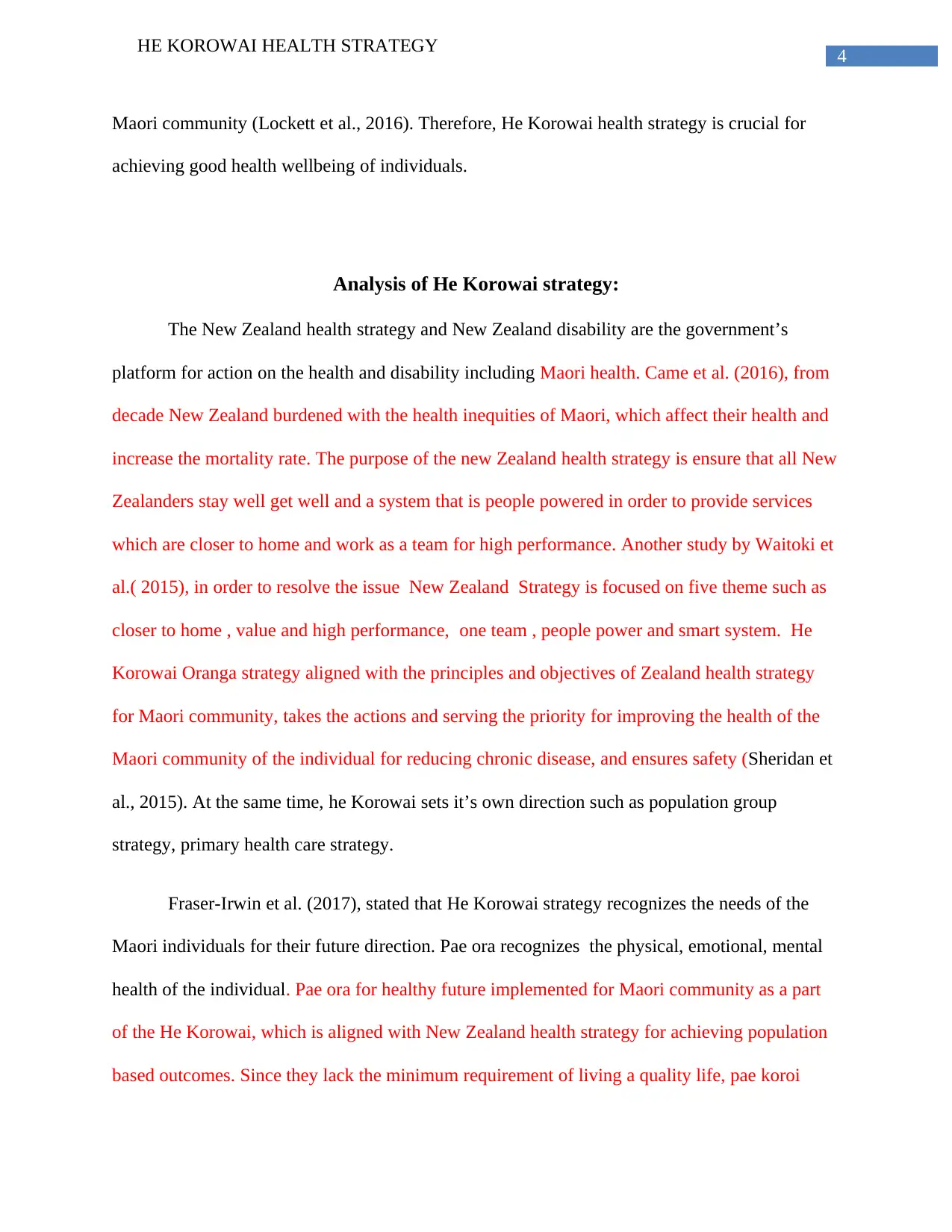
4
HE KOROWAI HEALTH STRATEGY
Maori community (Lockett et al., 2016). Therefore, He Korowai health strategy is crucial for
achieving good health wellbeing of individuals.
Analysis of He Korowai strategy:
The New Zealand health strategy and New Zealand disability are the government’s
platform for action on the health and disability including Maori health. Came et al. (2016), from
decade New Zealand burdened with the health inequities of Maori, which affect their health and
increase the mortality rate. The purpose of the new Zealand health strategy is ensure that all New
Zealanders stay well get well and a system that is people powered in order to provide services
which are closer to home and work as a team for high performance. Another study by Waitoki et
al.( 2015), in order to resolve the issue New Zealand Strategy is focused on five theme such as
closer to home , value and high performance, one team , people power and smart system. He
Korowai Oranga strategy aligned with the principles and objectives of Zealand health strategy
for Maori community, takes the actions and serving the priority for improving the health of the
Maori community of the individual for reducing chronic disease, and ensures safety (Sheridan et
al., 2015). At the same time, he Korowai sets it’s own direction such as population group
strategy, primary health care strategy.
Fraser-Irwin et al. (2017), stated that He Korowai strategy recognizes the needs of the
Maori individuals for their future direction. Pae ora recognizes the physical, emotional, mental
health of the individual. Pae ora for healthy future implemented for Maori community as a part
of the He Korowai, which is aligned with New Zealand health strategy for achieving population
based outcomes. Since they lack the minimum requirement of living a quality life, pae koroi
HE KOROWAI HEALTH STRATEGY
Maori community (Lockett et al., 2016). Therefore, He Korowai health strategy is crucial for
achieving good health wellbeing of individuals.
Analysis of He Korowai strategy:
The New Zealand health strategy and New Zealand disability are the government’s
platform for action on the health and disability including Maori health. Came et al. (2016), from
decade New Zealand burdened with the health inequities of Maori, which affect their health and
increase the mortality rate. The purpose of the new Zealand health strategy is ensure that all New
Zealanders stay well get well and a system that is people powered in order to provide services
which are closer to home and work as a team for high performance. Another study by Waitoki et
al.( 2015), in order to resolve the issue New Zealand Strategy is focused on five theme such as
closer to home , value and high performance, one team , people power and smart system. He
Korowai Oranga strategy aligned with the principles and objectives of Zealand health strategy
for Maori community, takes the actions and serving the priority for improving the health of the
Maori community of the individual for reducing chronic disease, and ensures safety (Sheridan et
al., 2015). At the same time, he Korowai sets it’s own direction such as population group
strategy, primary health care strategy.
Fraser-Irwin et al. (2017), stated that He Korowai strategy recognizes the needs of the
Maori individuals for their future direction. Pae ora recognizes the physical, emotional, mental
health of the individual. Pae ora for healthy future implemented for Maori community as a part
of the He Korowai, which is aligned with New Zealand health strategy for achieving population
based outcomes. Since they lack the minimum requirement of living a quality life, pae koroi
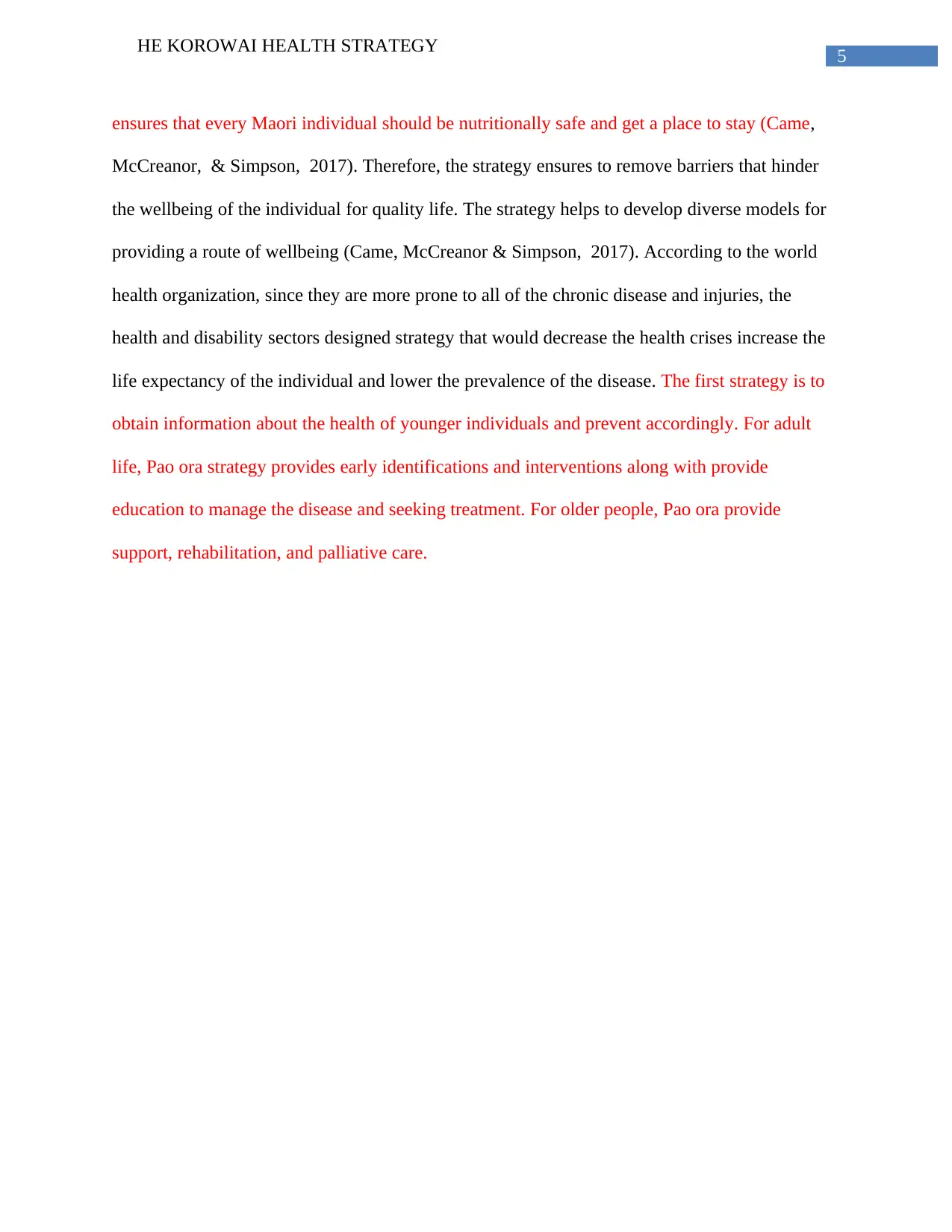
5
HE KOROWAI HEALTH STRATEGY
ensures that every Maori individual should be nutritionally safe and get a place to stay (Came,
McCreanor, & Simpson, 2017). Therefore, the strategy ensures to remove barriers that hinder
the wellbeing of the individual for quality life. The strategy helps to develop diverse models for
providing a route of wellbeing (Came, McCreanor & Simpson, 2017). According to the world
health organization, since they are more prone to all of the chronic disease and injuries, the
health and disability sectors designed strategy that would decrease the health crises increase the
life expectancy of the individual and lower the prevalence of the disease. The first strategy is to
obtain information about the health of younger individuals and prevent accordingly. For adult
life, Pao ora strategy provides early identifications and interventions along with provide
education to manage the disease and seeking treatment. For older people, Pao ora provide
support, rehabilitation, and palliative care.
HE KOROWAI HEALTH STRATEGY
ensures that every Maori individual should be nutritionally safe and get a place to stay (Came,
McCreanor, & Simpson, 2017). Therefore, the strategy ensures to remove barriers that hinder
the wellbeing of the individual for quality life. The strategy helps to develop diverse models for
providing a route of wellbeing (Came, McCreanor & Simpson, 2017). According to the world
health organization, since they are more prone to all of the chronic disease and injuries, the
health and disability sectors designed strategy that would decrease the health crises increase the
life expectancy of the individual and lower the prevalence of the disease. The first strategy is to
obtain information about the health of younger individuals and prevent accordingly. For adult
life, Pao ora strategy provides early identifications and interventions along with provide
education to manage the disease and seeking treatment. For older people, Pao ora provide
support, rehabilitation, and palliative care.
⊘ This is a preview!⊘
Do you want full access?
Subscribe today to unlock all pages.

Trusted by 1+ million students worldwide
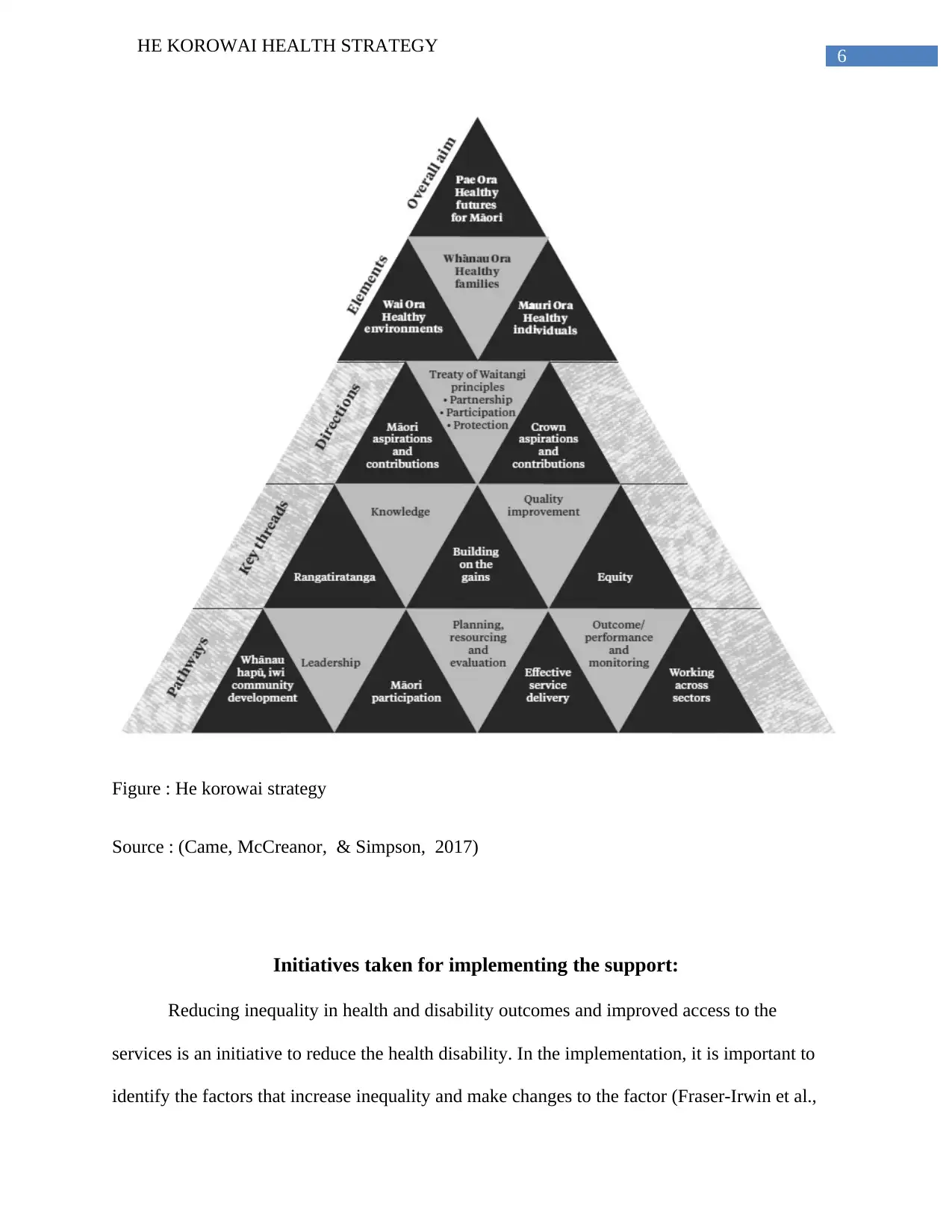
6
HE KOROWAI HEALTH STRATEGY
Figure : He korowai strategy
Source : (Came, McCreanor, & Simpson, 2017)
Initiatives taken for implementing the support:
Reducing inequality in health and disability outcomes and improved access to the
services is an initiative to reduce the health disability. In the implementation, it is important to
identify the factors that increase inequality and make changes to the factor (Fraser-Irwin et al.,
HE KOROWAI HEALTH STRATEGY
Figure : He korowai strategy
Source : (Came, McCreanor, & Simpson, 2017)
Initiatives taken for implementing the support:
Reducing inequality in health and disability outcomes and improved access to the
services is an initiative to reduce the health disability. In the implementation, it is important to
identify the factors that increase inequality and make changes to the factor (Fraser-Irwin et al.,
Paraphrase This Document
Need a fresh take? Get an instant paraphrase of this document with our AI Paraphraser
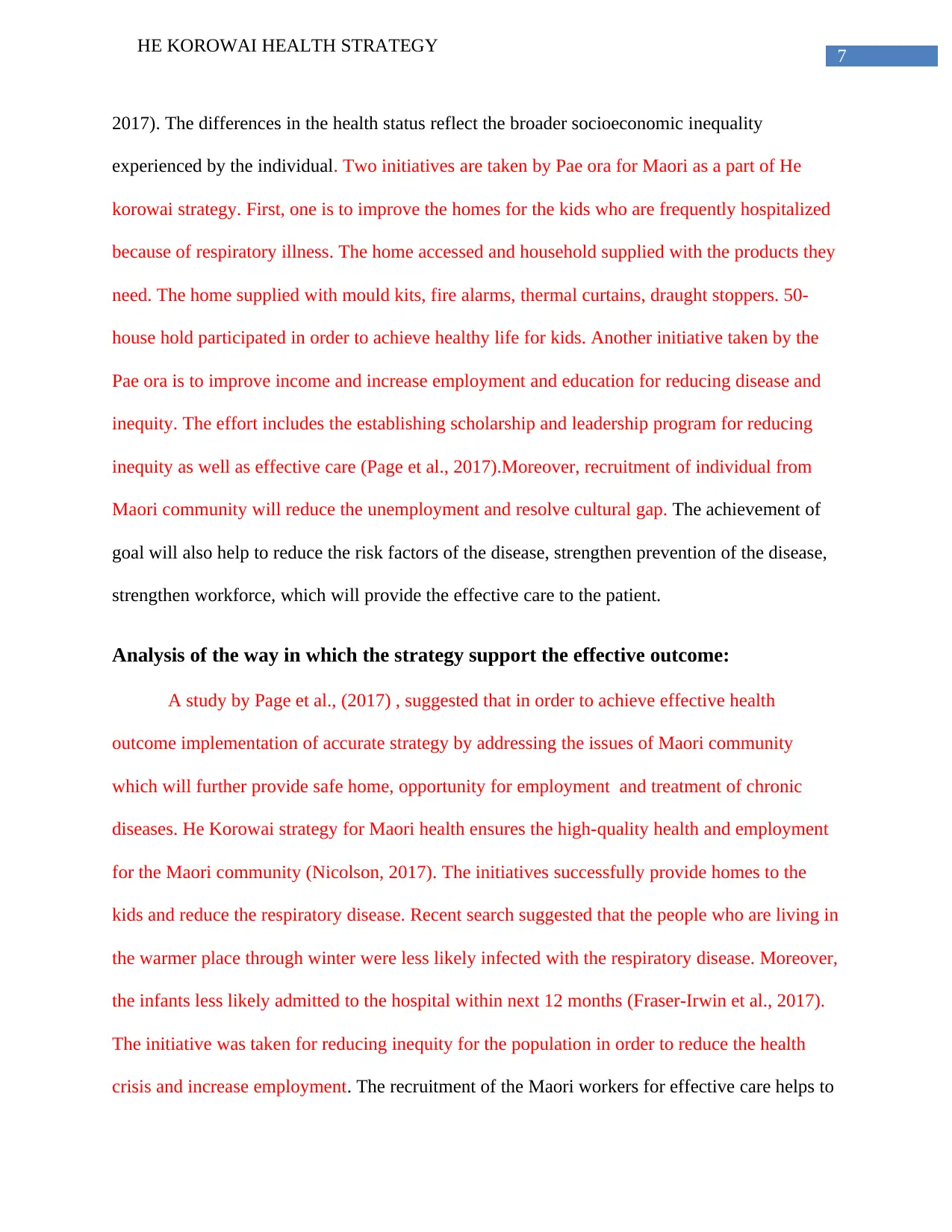
7
HE KOROWAI HEALTH STRATEGY
2017). The differences in the health status reflect the broader socioeconomic inequality
experienced by the individual. Two initiatives are taken by Pae ora for Maori as a part of He
korowai strategy. First, one is to improve the homes for the kids who are frequently hospitalized
because of respiratory illness. The home accessed and household supplied with the products they
need. The home supplied with mould kits, fire alarms, thermal curtains, draught stoppers. 50-
house hold participated in order to achieve healthy life for kids. Another initiative taken by the
Pae ora is to improve income and increase employment and education for reducing disease and
inequity. The effort includes the establishing scholarship and leadership program for reducing
inequity as well as effective care (Page et al., 2017).Moreover, recruitment of individual from
Maori community will reduce the unemployment and resolve cultural gap. The achievement of
goal will also help to reduce the risk factors of the disease, strengthen prevention of the disease,
strengthen workforce, which will provide the effective care to the patient.
Analysis of the way in which the strategy support the effective outcome:
A study by Page et al., (2017) , suggested that in order to achieve effective health
outcome implementation of accurate strategy by addressing the issues of Maori community
which will further provide safe home, opportunity for employment and treatment of chronic
diseases. He Korowai strategy for Maori health ensures the high-quality health and employment
for the Maori community (Nicolson, 2017). The initiatives successfully provide homes to the
kids and reduce the respiratory disease. Recent search suggested that the people who are living in
the warmer place through winter were less likely infected with the respiratory disease. Moreover,
the infants less likely admitted to the hospital within next 12 months (Fraser-Irwin et al., 2017).
The initiative was taken for reducing inequity for the population in order to reduce the health
crisis and increase employment. The recruitment of the Maori workers for effective care helps to
HE KOROWAI HEALTH STRATEGY
2017). The differences in the health status reflect the broader socioeconomic inequality
experienced by the individual. Two initiatives are taken by Pae ora for Maori as a part of He
korowai strategy. First, one is to improve the homes for the kids who are frequently hospitalized
because of respiratory illness. The home accessed and household supplied with the products they
need. The home supplied with mould kits, fire alarms, thermal curtains, draught stoppers. 50-
house hold participated in order to achieve healthy life for kids. Another initiative taken by the
Pae ora is to improve income and increase employment and education for reducing disease and
inequity. The effort includes the establishing scholarship and leadership program for reducing
inequity as well as effective care (Page et al., 2017).Moreover, recruitment of individual from
Maori community will reduce the unemployment and resolve cultural gap. The achievement of
goal will also help to reduce the risk factors of the disease, strengthen prevention of the disease,
strengthen workforce, which will provide the effective care to the patient.
Analysis of the way in which the strategy support the effective outcome:
A study by Page et al., (2017) , suggested that in order to achieve effective health
outcome implementation of accurate strategy by addressing the issues of Maori community
which will further provide safe home, opportunity for employment and treatment of chronic
diseases. He Korowai strategy for Maori health ensures the high-quality health and employment
for the Maori community (Nicolson, 2017). The initiatives successfully provide homes to the
kids and reduce the respiratory disease. Recent search suggested that the people who are living in
the warmer place through winter were less likely infected with the respiratory disease. Moreover,
the infants less likely admitted to the hospital within next 12 months (Fraser-Irwin et al., 2017).
The initiative was taken for reducing inequity for the population in order to reduce the health
crisis and increase employment. The recruitment of the Maori workers for effective care helps to
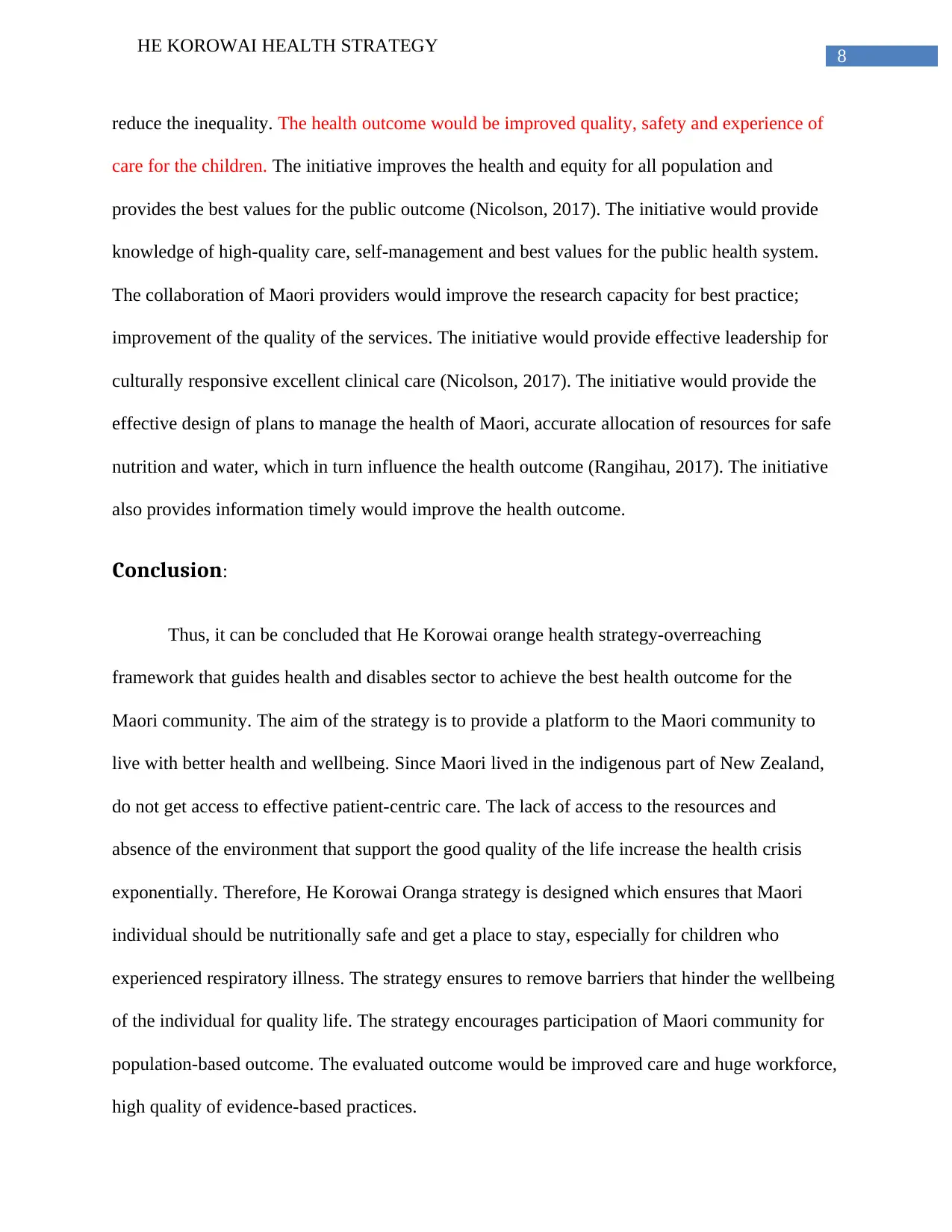
8
HE KOROWAI HEALTH STRATEGY
reduce the inequality. The health outcome would be improved quality, safety and experience of
care for the children. The initiative improves the health and equity for all population and
provides the best values for the public outcome (Nicolson, 2017). The initiative would provide
knowledge of high-quality care, self-management and best values for the public health system.
The collaboration of Maori providers would improve the research capacity for best practice;
improvement of the quality of the services. The initiative would provide effective leadership for
culturally responsive excellent clinical care (Nicolson, 2017). The initiative would provide the
effective design of plans to manage the health of Maori, accurate allocation of resources for safe
nutrition and water, which in turn influence the health outcome (Rangihau, 2017). The initiative
also provides information timely would improve the health outcome.
Conclusion:
Thus, it can be concluded that He Korowai orange health strategy-overreaching
framework that guides health and disables sector to achieve the best health outcome for the
Maori community. The aim of the strategy is to provide a platform to the Maori community to
live with better health and wellbeing. Since Maori lived in the indigenous part of New Zealand,
do not get access to effective patient-centric care. The lack of access to the resources and
absence of the environment that support the good quality of the life increase the health crisis
exponentially. Therefore, He Korowai Oranga strategy is designed which ensures that Maori
individual should be nutritionally safe and get a place to stay, especially for children who
experienced respiratory illness. The strategy ensures to remove barriers that hinder the wellbeing
of the individual for quality life. The strategy encourages participation of Maori community for
population-based outcome. The evaluated outcome would be improved care and huge workforce,
high quality of evidence-based practices.
HE KOROWAI HEALTH STRATEGY
reduce the inequality. The health outcome would be improved quality, safety and experience of
care for the children. The initiative improves the health and equity for all population and
provides the best values for the public outcome (Nicolson, 2017). The initiative would provide
knowledge of high-quality care, self-management and best values for the public health system.
The collaboration of Maori providers would improve the research capacity for best practice;
improvement of the quality of the services. The initiative would provide effective leadership for
culturally responsive excellent clinical care (Nicolson, 2017). The initiative would provide the
effective design of plans to manage the health of Maori, accurate allocation of resources for safe
nutrition and water, which in turn influence the health outcome (Rangihau, 2017). The initiative
also provides information timely would improve the health outcome.
Conclusion:
Thus, it can be concluded that He Korowai orange health strategy-overreaching
framework that guides health and disables sector to achieve the best health outcome for the
Maori community. The aim of the strategy is to provide a platform to the Maori community to
live with better health and wellbeing. Since Maori lived in the indigenous part of New Zealand,
do not get access to effective patient-centric care. The lack of access to the resources and
absence of the environment that support the good quality of the life increase the health crisis
exponentially. Therefore, He Korowai Oranga strategy is designed which ensures that Maori
individual should be nutritionally safe and get a place to stay, especially for children who
experienced respiratory illness. The strategy ensures to remove barriers that hinder the wellbeing
of the individual for quality life. The strategy encourages participation of Maori community for
population-based outcome. The evaluated outcome would be improved care and huge workforce,
high quality of evidence-based practices.
⊘ This is a preview!⊘
Do you want full access?
Subscribe today to unlock all pages.

Trusted by 1+ million students worldwide
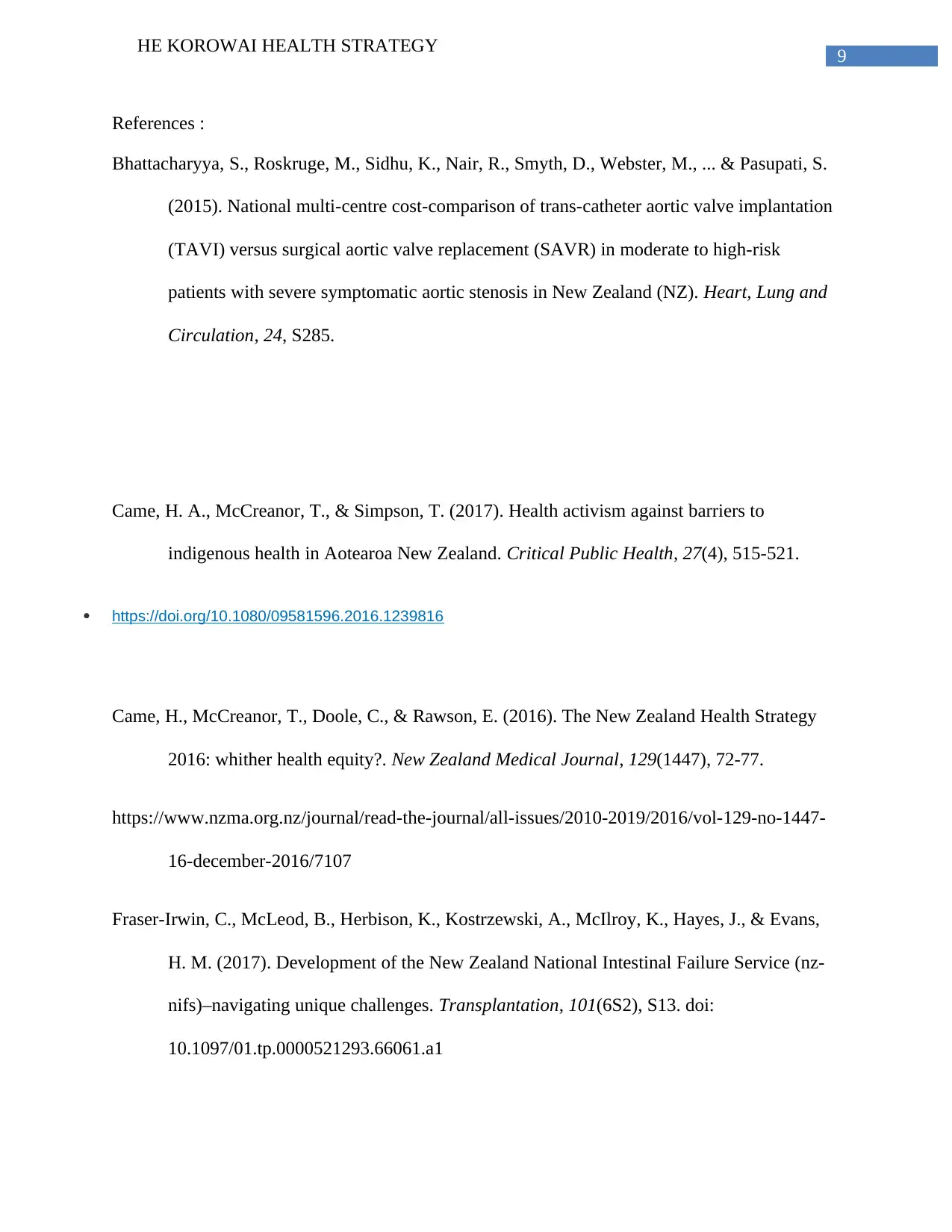
9
HE KOROWAI HEALTH STRATEGY
References :
Bhattacharyya, S., Roskruge, M., Sidhu, K., Nair, R., Smyth, D., Webster, M., ... & Pasupati, S.
(2015). National multi-centre cost-comparison of trans-catheter aortic valve implantation
(TAVI) versus surgical aortic valve replacement (SAVR) in moderate to high-risk
patients with severe symptomatic aortic stenosis in New Zealand (NZ). Heart, Lung and
Circulation, 24, S285.
Came, H. A., McCreanor, T., & Simpson, T. (2017). Health activism against barriers to
indigenous health in Aotearoa New Zealand. Critical Public Health, 27(4), 515-521.
https://doi.org/10.1080/09581596.2016.1239816
Came, H., McCreanor, T., Doole, C., & Rawson, E. (2016). The New Zealand Health Strategy
2016: whither health equity?. New Zealand Medical Journal, 129(1447), 72-77.
https://www.nzma.org.nz/journal/read-the-journal/all-issues/2010-2019/2016/vol-129-no-1447-
16-december-2016/7107
Fraser-Irwin, C., McLeod, B., Herbison, K., Kostrzewski, A., McIlroy, K., Hayes, J., & Evans,
H. M. (2017). Development of the New Zealand National Intestinal Failure Service (nz-
nifs)–navigating unique challenges. Transplantation, 101(6S2), S13. doi:
10.1097/01.tp.0000521293.66061.a1
HE KOROWAI HEALTH STRATEGY
References :
Bhattacharyya, S., Roskruge, M., Sidhu, K., Nair, R., Smyth, D., Webster, M., ... & Pasupati, S.
(2015). National multi-centre cost-comparison of trans-catheter aortic valve implantation
(TAVI) versus surgical aortic valve replacement (SAVR) in moderate to high-risk
patients with severe symptomatic aortic stenosis in New Zealand (NZ). Heart, Lung and
Circulation, 24, S285.
Came, H. A., McCreanor, T., & Simpson, T. (2017). Health activism against barriers to
indigenous health in Aotearoa New Zealand. Critical Public Health, 27(4), 515-521.
https://doi.org/10.1080/09581596.2016.1239816
Came, H., McCreanor, T., Doole, C., & Rawson, E. (2016). The New Zealand Health Strategy
2016: whither health equity?. New Zealand Medical Journal, 129(1447), 72-77.
https://www.nzma.org.nz/journal/read-the-journal/all-issues/2010-2019/2016/vol-129-no-1447-
16-december-2016/7107
Fraser-Irwin, C., McLeod, B., Herbison, K., Kostrzewski, A., McIlroy, K., Hayes, J., & Evans,
H. M. (2017). Development of the New Zealand National Intestinal Failure Service (nz-
nifs)–navigating unique challenges. Transplantation, 101(6S2), S13. doi:
10.1097/01.tp.0000521293.66061.a1
Paraphrase This Document
Need a fresh take? Get an instant paraphrase of this document with our AI Paraphraser
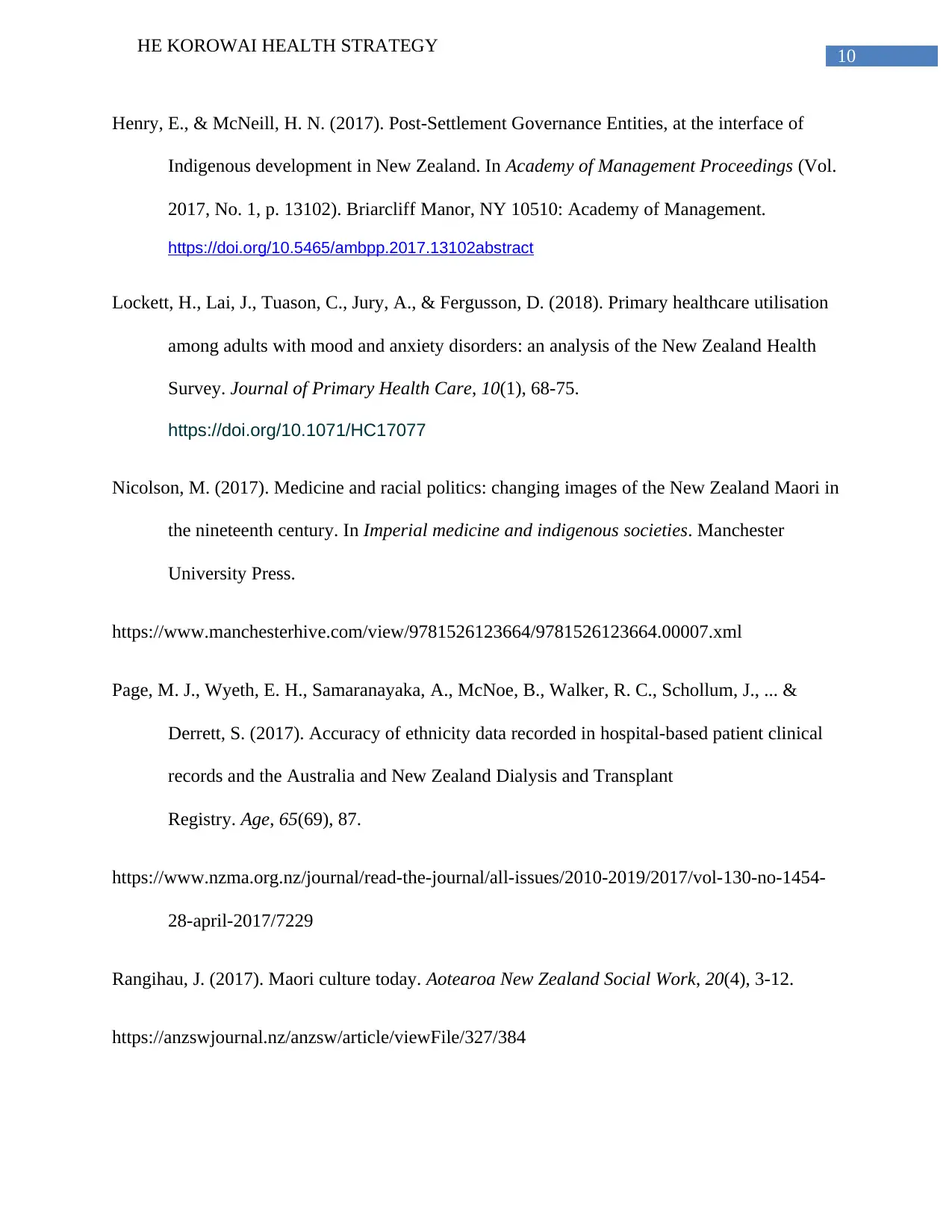
10
HE KOROWAI HEALTH STRATEGY
Henry, E., & McNeill, H. N. (2017). Post-Settlement Governance Entities, at the interface of
Indigenous development in New Zealand. In Academy of Management Proceedings (Vol.
2017, No. 1, p. 13102). Briarcliff Manor, NY 10510: Academy of Management.
https://doi.org/10.5465/ambpp.2017.13102abstract
Lockett, H., Lai, J., Tuason, C., Jury, A., & Fergusson, D. (2018). Primary healthcare utilisation
among adults with mood and anxiety disorders: an analysis of the New Zealand Health
Survey. Journal of Primary Health Care, 10(1), 68-75.
https://doi.org/10.1071/HC17077
Nicolson, M. (2017). Medicine and racial politics: changing images of the New Zealand Maori in
the nineteenth century. In Imperial medicine and indigenous societies. Manchester
University Press.
https://www.manchesterhive.com/view/9781526123664/9781526123664.00007.xml
Page, M. J., Wyeth, E. H., Samaranayaka, A., McNoe, B., Walker, R. C., Schollum, J., ... &
Derrett, S. (2017). Accuracy of ethnicity data recorded in hospital-based patient clinical
records and the Australia and New Zealand Dialysis and Transplant
Registry. Age, 65(69), 87.
https://www.nzma.org.nz/journal/read-the-journal/all-issues/2010-2019/2017/vol-130-no-1454-
28-april-2017/7229
Rangihau, J. (2017). Maori culture today. Aotearoa New Zealand Social Work, 20(4), 3-12.
https://anzswjournal.nz/anzsw/article/viewFile/327/384
HE KOROWAI HEALTH STRATEGY
Henry, E., & McNeill, H. N. (2017). Post-Settlement Governance Entities, at the interface of
Indigenous development in New Zealand. In Academy of Management Proceedings (Vol.
2017, No. 1, p. 13102). Briarcliff Manor, NY 10510: Academy of Management.
https://doi.org/10.5465/ambpp.2017.13102abstract
Lockett, H., Lai, J., Tuason, C., Jury, A., & Fergusson, D. (2018). Primary healthcare utilisation
among adults with mood and anxiety disorders: an analysis of the New Zealand Health
Survey. Journal of Primary Health Care, 10(1), 68-75.
https://doi.org/10.1071/HC17077
Nicolson, M. (2017). Medicine and racial politics: changing images of the New Zealand Maori in
the nineteenth century. In Imperial medicine and indigenous societies. Manchester
University Press.
https://www.manchesterhive.com/view/9781526123664/9781526123664.00007.xml
Page, M. J., Wyeth, E. H., Samaranayaka, A., McNoe, B., Walker, R. C., Schollum, J., ... &
Derrett, S. (2017). Accuracy of ethnicity data recorded in hospital-based patient clinical
records and the Australia and New Zealand Dialysis and Transplant
Registry. Age, 65(69), 87.
https://www.nzma.org.nz/journal/read-the-journal/all-issues/2010-2019/2017/vol-130-no-1454-
28-april-2017/7229
Rangihau, J. (2017). Maori culture today. Aotearoa New Zealand Social Work, 20(4), 3-12.
https://anzswjournal.nz/anzsw/article/viewFile/327/384
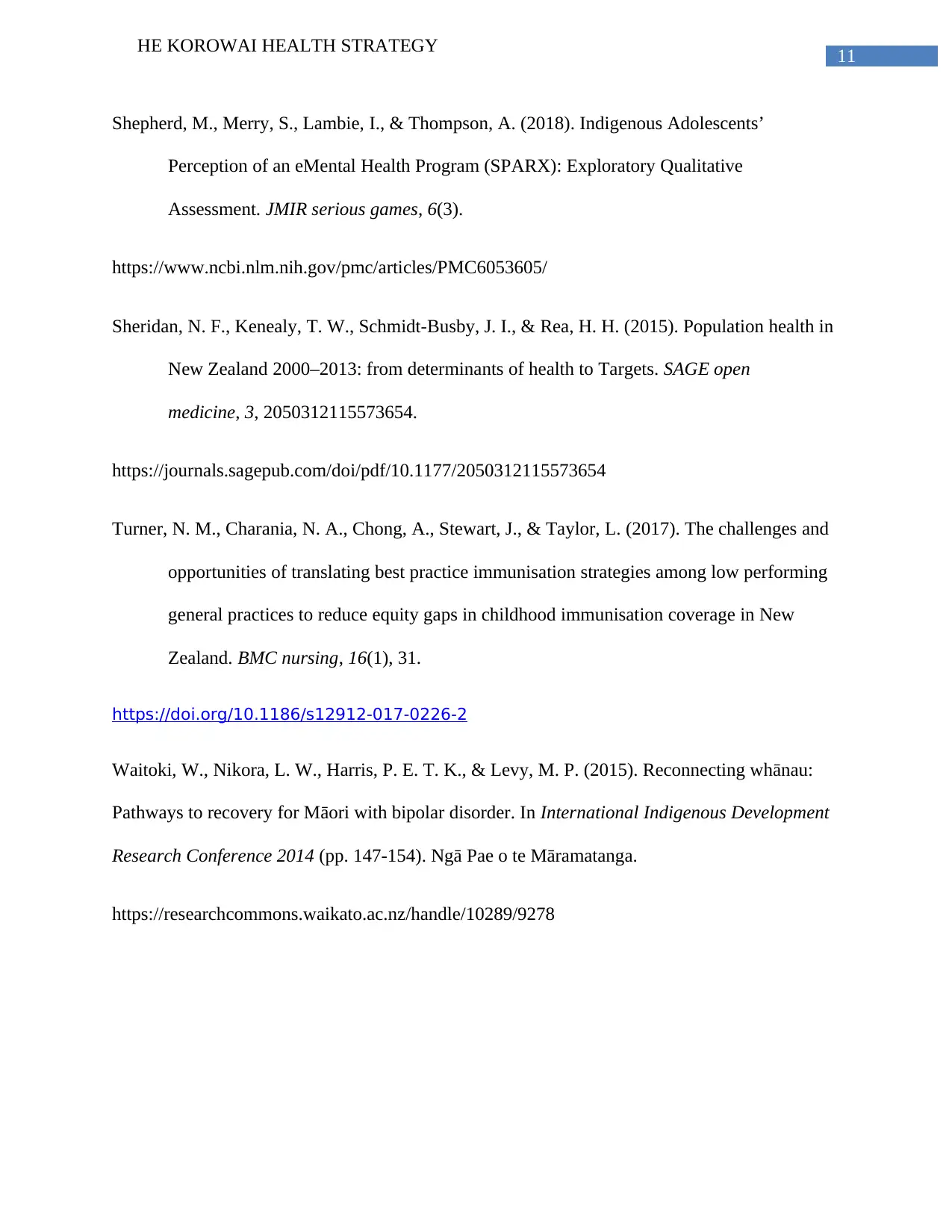
11
HE KOROWAI HEALTH STRATEGY
Shepherd, M., Merry, S., Lambie, I., & Thompson, A. (2018). Indigenous Adolescents’
Perception of an eMental Health Program (SPARX): Exploratory Qualitative
Assessment. JMIR serious games, 6(3).
https://www.ncbi.nlm.nih.gov/pmc/articles/PMC6053605/
Sheridan, N. F., Kenealy, T. W., Schmidt-Busby, J. I., & Rea, H. H. (2015). Population health in
New Zealand 2000–2013: from determinants of health to Targets. SAGE open
medicine, 3, 2050312115573654.
https://journals.sagepub.com/doi/pdf/10.1177/2050312115573654
Turner, N. M., Charania, N. A., Chong, A., Stewart, J., & Taylor, L. (2017). The challenges and
opportunities of translating best practice immunisation strategies among low performing
general practices to reduce equity gaps in childhood immunisation coverage in New
Zealand. BMC nursing, 16(1), 31.
https://doi.org/10.1186/s12912-017-0226-2
Waitoki, W., Nikora, L. W., Harris, P. E. T. K., & Levy, M. P. (2015). Reconnecting whānau:
Pathways to recovery for Māori with bipolar disorder. In International Indigenous Development
Research Conference 2014 (pp. 147-154). Ngā Pae o te Māramatanga.
https://researchcommons.waikato.ac.nz/handle/10289/9278
HE KOROWAI HEALTH STRATEGY
Shepherd, M., Merry, S., Lambie, I., & Thompson, A. (2018). Indigenous Adolescents’
Perception of an eMental Health Program (SPARX): Exploratory Qualitative
Assessment. JMIR serious games, 6(3).
https://www.ncbi.nlm.nih.gov/pmc/articles/PMC6053605/
Sheridan, N. F., Kenealy, T. W., Schmidt-Busby, J. I., & Rea, H. H. (2015). Population health in
New Zealand 2000–2013: from determinants of health to Targets. SAGE open
medicine, 3, 2050312115573654.
https://journals.sagepub.com/doi/pdf/10.1177/2050312115573654
Turner, N. M., Charania, N. A., Chong, A., Stewart, J., & Taylor, L. (2017). The challenges and
opportunities of translating best practice immunisation strategies among low performing
general practices to reduce equity gaps in childhood immunisation coverage in New
Zealand. BMC nursing, 16(1), 31.
https://doi.org/10.1186/s12912-017-0226-2
Waitoki, W., Nikora, L. W., Harris, P. E. T. K., & Levy, M. P. (2015). Reconnecting whānau:
Pathways to recovery for Māori with bipolar disorder. In International Indigenous Development
Research Conference 2014 (pp. 147-154). Ngā Pae o te Māramatanga.
https://researchcommons.waikato.ac.nz/handle/10289/9278
⊘ This is a preview!⊘
Do you want full access?
Subscribe today to unlock all pages.

Trusted by 1+ million students worldwide
1 out of 12
Related Documents
Your All-in-One AI-Powered Toolkit for Academic Success.
+13062052269
info@desklib.com
Available 24*7 on WhatsApp / Email
![[object Object]](/_next/static/media/star-bottom.7253800d.svg)
Unlock your academic potential
Copyright © 2020–2025 A2Z Services. All Rights Reserved. Developed and managed by ZUCOL.





